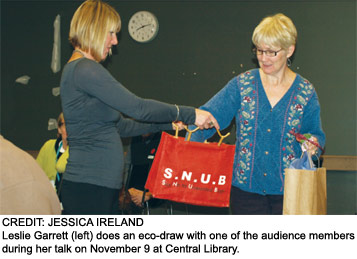Dreaming of a green Christmas

Whether your holiday style is Grinch-y or giddy, the season can always use a bit more green.
Rampant consumerism has almost become its own holiday tradition, but this year may see a change.
The CBC has noted that a lot of retailers are predicting a tepid Christmas this year, with more families focusing on giving than getting, said Leslie Garrett, author of the Virtuous Consumer and green correspondent for A Channel and the CBC, during her lecture on “Greening Your Holidays” at the Central branch of London Public Library.
But some may find it hard to make the switch because the pressure of a “perfect Christmas,” with the perfectly chosen gifts and dinner, is still part of the season and big part of the waste North Americans produce each year.
For example, 41 per cent of Christmas toys will be broken within the first month and 25 per cent of the waste we produce in one year is during the time between the American Thanksgiving and Christmas, said Garrett.
One thing that helps the environmental cost of the holidays is to focus locally. Local food is a delicious change to make. But when you're sourcing meat, it's important to look at how the animals are raised, advised Garrett.
Much of what you see in the grocery store isn't pasture-raised meat. Usually it's pumped full of hormones. Sometimes chickens are fed so many hormones, they can't even stand up because they're raised just to produce impressive breast meat, which is the most desirable to consumers, said Garrett. Getting to know your local farmer can help you get peace of mind over what you're putting on your table. Healthy animals mean a healthier you, as well.
Then there's the all-important tree. The debate is often between a faux fir and the real deal. But both can be okay for the environment, said Garrett. If you've had a fake tree in your family for years, it's likely finished off-gassing — fake trees are often made of some fairly toxic materials — so it's better to keep using it, rather than tossing it in favour of a real one, she said.
But if your family is into that piney fresh smell, cutting down trees isn't a detriment to the forest — as long as you go to a designated location where these trees are grown for this purpose.
As for the usual decorations — stick to the classics, said Garrett. And by classics, she means the ones that have been in your family for years. There is no need to buy new ones each year. You can also experiment with natural d�cor, she suggested. She uses an old bowl, real cranberries, water, holly, pine boughs and floating soy-based candles as her centerpiece.
But what about gifts? If you have children, don't overwhelm them with a tree bulging at the bottom with toys. Garrett told the story of her eldest child, when she was two, who was content with just her stocking and how confused she was by the mound of gifts. It bothered Garrett that “on some level, we were taking a simple experience and sullying it.”
“Gifts can be wonderful, but it's gotten out of control,” she said.
Try giving experiences, like a massage, volunteering to cook a friend a three-course meal or teaching someone a skill.
For online-shoppers, don't feel too guilty about shipping gifts from out of town. Consider that with every delivery truck on the road, there are nine less vehicles out there heading to the mall, said Garrett.
Cutting back during the holidays doesn't mean you have to cut back on the fun the season brings.
“Most of us aren't looking for more stuff, we're looking for more meaning,” said Garrett. “It really is about getting back to what Christmas is really about.”
Quoting Dr. Seuss, she added, “Maybe Christmas ... doesn't come from a store. Maybe Christmas ... perhaps ... means a little bit more.”













